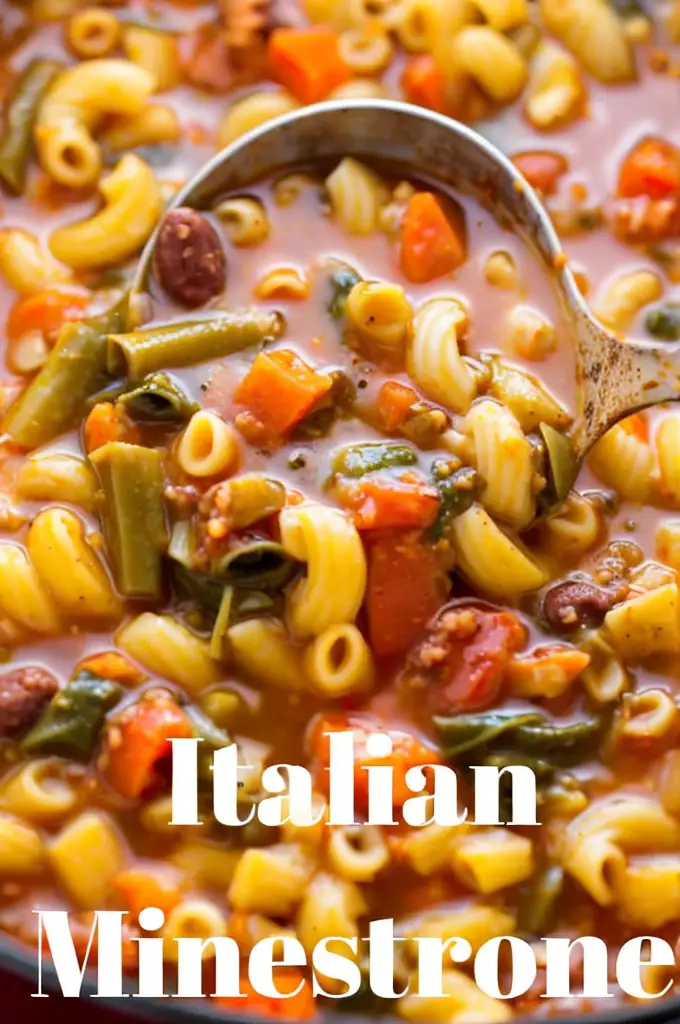Best Italian Minestrone Soup – Ready in 30 Minutes
Indulge in the heartwarming comfort of the Best Italian Minestrone Soup, a delightful medley of fresh vegetables and fragrant herbs. With its vibrant colors and bold flavors, this dish brings the essence of Italy right to your table. Ready in just 30 minutes, it’s the perfect blend of convenience and tradition, making it an ideal choice for a cozy family dinner or a quick weeknight meal. Each spoonful offers a tasty and nourishing experience as comforting as an Italian villa’s kitchen.
Quick Recipe Highlights
- Flavor Profile: A rich and savory blend of tomatoes, beans, and Italian herbs complemented with light undertones of garlic and onion.
- Texture: A harmonious mix of tender vegetables, hearty beans, and delicate pasta or rice, providing a fulfilling mouthfeel.
- Aroma: The intoxicating scent of fresh basil, oregano, garlic, and bay leaf fills the kitchen, evoking thoughts of rustic Italian homes.
- Visual Appeal: A colorful feast for the eyes, with hues of green zucchini, orange carrots, and red tomatoes topped with a sprinkle of parsley.
- Skill Level Needed: No advanced skills are necessary—simple sauté and simmer techniques are all it takes to create this masterpiece.
- Special Equipment: A large pot or Dutch oven is essential to prepare this one-pot wonder with ease.
Recipe Overview
- Difficulty Level: This soup is categorized as easy due to its straightforward preparation and minimal cooking techniques.
- Category: Perfect as a nutritious lunch or a comforting evening meal, this soup caters to both light and hearty appetites.
- Cuisine: Rooted in Italian culinary traditions, this recipe highlights rustic flavors and seasonal produce.
- Cost: With accessible ingredients like canned beans and essential vegetables, this meal is budget-friendly, typically costing under $10.
- Season: Minestrone is versatile for all seasons, making great use of either fresh spring produce or winter storage vegetables.
- Occasion: This dish suits everyday meals and special family gatherings, bringing warmth and togetherness to any table.
Why You’ll Love This Recipe
The Best Italian Minestrone Soup will captivate you with its rich taste and balanced texture. A blend of fresh vegetables simmered in a seasoned tomato broth makes each spoonful a delightful experience. Busy cooks and food lovers alike will appreciate how simply and quickly this recipe comes together. With minimal prep and cooking time, it’s perfect for those on the go yet craving authenticity. Nutritionally, this soup is a powerhouse — packed with fiber, vitamins, and low calories, it’s a guilt-free indulgence. Additionally, its social value cannot be overstated. It acts as a conversation starter at gatherings, embodying the Italian spirit of sharing and togetherness. Economically, it’s not just wallet-friendly but also scalable for larger groups or meal-prepping enthusiasts.
Historical Background and Cultural Significance
The history of Minestrone soup is as rich as its ingredients. This dish dates back to ancient Rome, initially a humble stew of leftover vegetables. Its evolution mirrored Italy’s agrarian transformations, becoming a staple in peasant diets. Minestrone holds cultural significance as a symbol of Italian cucina povera — making the most with little. Over centuries, variations emerged across different regions in Italy, each making the recipe their own by incorporating local produce. The north prefers rice-based versions, while central Italy favors pasta. Despite its modest origins, Minestrone now graces tables worldwide, often adapted to suit seasonal ingredients and local tastes.
Ingredient Deep Dive
Carrots bring natural sweetness and a vibrant color to the soup. Historically, carrots have been a cornerstone in Italian cooking, prized for their versatility and nutritional value, boasting high levels of beta-carotene and fiber. When selecting carrots, opt for firm, bright, and smooth-skin specimens. Store them in the refrigerator crisper drawer for up to two weeks. As a substitution, parsnips can offer a similar texture with a slightly earthier taste. Tomatoes form the heart of Minestrone, offering acidity and depth of flavor. Packed with antioxidants, particularly vitamin C and lycopene, tomatoes are renowned in Italian cuisine for their health benefits. Opt for ripe, deep-red tomatoes, preferably fresh Roma or canned San Marzano for a rich taste. Store canned tomatoes in a cool place, while fresh tomatoes should be kept at room temperature until ripe.
Common Mistakes to Avoid
- Adding all vegetables at once instead of according to their cooking time can result in inconsistencies. Stagger additions based on texture preference.
- Under-seasoning is a common issue; without proper seasoning, the flavors can remain muted. Adjust salt and herbs gradually.
- Overcooking pasta or rice may lead to a mushy texture. Ensure these ingredients are cooked al dente and added close to serving.
- Skipping the sautéing step for your base vegetables means missing out on developed flavors. This crucial step builds the soup’s foundation.
- Using canned beans without rinsing increases sodium levels and alter flavors; always rinse before adding.
- Not simmering long enough can result in raw-tasting vegetables—a proper simmer enhances flavors.
- Neglecting to taste and adjust flavors before serving can leave food bland. Taste and tweak seasoning for optimal results.
- Ignoring fresh herbs as a garnish means missing bright and fresh flavors. Add right before serving for maximum impact.
Essential Techniques
The key to the perfect Minestrone Soup lies in its base, beginning with a mirepoix of onions, carrots, and celery. This trifecta is sautéed until soft, releasing aromatics that form the soup’s heart. Sautéing is crucial as it unlocks deeper flavors that boiling alone cannot achieve. Master this by maintaining moderate heat and stirring frequently to prevent burning. Keep an eye on the color, aiming for translucent, not browned, vegetables. Correct seasoning is another vital component. It’s essential to taste as you go, balancing salt with the sweetness from carrots and acidity from tomatoes. Herbs bring aromatic richness, so adjust these according to preference, but always add fresh herbs near the end to preserve their delicate flavors.
Pro Tips for Perfect Minestrone Soup
– For enhanced depth, use homemade vegetable broth, which often carries better flavors than store-bought ones.
– If using pasta or rice, cook it separately and add just before serving to avoid it soaking up too much broth.
– Always deglaze the pot with a bit of wine or stock after sautéing vegetables, which adds an extra layer of flavor.
– Fresh herbs, particularly basil and parsley, should be gently torn rather than chopped to preserve their aromatic oils.
– A small Parmesan cheese rind simmered with the soup can impart a subtle cheesy umami flavor without overpowering.
– If a thicker consistency is desired, mash or blend a portion of the soup and return to the pot.
– Utilize seasonal veggies for a variety of flavor profiles; root veggies in winter and zucchini or green beans in summer.
– Acid at the end can brighten flavors — a dash of vinegar or lemon juice added at the last moment can elevate the dish.
Variations and Adaptations
Regional adaptations are the soul of traditional Minestrone, as each area in Italy stamps its signature on this classic. Northern regions, known for their rich, buttery dishes, might incorporate pancetta or alpine cheese while Tuscan versions often welcome beans and kale, enjoying their agricultural bounty. For seasonal adaptations, swap summer’s zucchini and green beans for winter’s root vegetables like parsnips or butternut squash. Dietary modifications can include using gluten-free pasta or omitting it entirely for a lighter carb meal option. Vegans can relish a taste sans Parmesan rind, still reveling in the earthiness of herbs. Experimenting with flavors such as a spice boost with chili flakes or texture contrast with toasted seeds and nuts can further personalize the dish.
Serving and Presentation Guide
Plating Minestrone Soup offers a chance to showcase its vibrant components. Serve in deep bowls to maintain warmth while emphasizing its consomme-like texture. Garnish with torn basil or parsley leaves for a pop of color, or indulge with a fine grating of Parmesan cheese. Traditionally accompanied by crusty Italian bread, it’s perfect for soaking up every last drop. For a modern twist, offer alongside garlic crostini for an added crunch complement. Ensure the soup is piping hot, which enhances the aroma as it mingles with steam, entices the senses, and pleases the palate. Consider portioning in smaller, elegant bowls for social gatherings to give a refined, gourmet feel.
Wine and Beverage Pairing
Pairing Minestrone with wines offers endless possibilities. An Italian Chianti, with its medium body and notable acidity, enhances the soup’s tomato base and counters its richness. A crisp Pinot Grigio provides a refreshing balance to the hearty ingredients. For non-alcoholic alternatives, consider a sparkling water with a hint of lemon to cleanse the palate. Serve beverages slightly chilled but not icy, maintaining emphasis on the soup’s warmth. In colder seasons, an earthy oolong tea offers a different yet complementary pairing, mirroring the soup’s rustic essence. Proper pairing elevates the dining experience from comforting to extraordinary.
Storage and Shelf Life
Proper storage extends the freshness of your Minestrone Soup. Allow the soup to cool before transferring it to an airtight container, ideally glass to prevent acidity from interacting. Refrigeration keeps it fresh for up to five days, while freezing allows it to last up to three months. Upon reheating, use gentle, even heat to thoroughly warm without overcooking the vegetables. If frozen, thaw in the refrigerator overnight before reheating. Be mindful of spoilage signs such as off smells or a change in color. When reheating, consider adding fresh herbs or cooked pasta to refresh the soup to its original glory.
Make Ahead Strategies
Minestrone Soup excels as a make-ahead dish, ideal for meal prep enthusiasts. Begin by prepping and chopping all your vegetables up to three days prior. Assemble the soup, stopping just before adding delicate ingredients like spinach or pasta—these can be added during reheating to maintain texture. Storing components separately helps retain optimal flavor. To reheat, simmer gently and finish with fresh elements, ensuring it tastes abundantly fresh. Elevating flavors can be done by stirring in a drizzle of good olive oil or a dash of balsamic vinegar once warm, reinvigorating the taste profile.
Scaling Instructions
Whether serving a cozy family dinner or a large gathering, Minestrone Soup can effortlessly scale. Halve the recipe for intimate meals or double it for a crowd. Adjust the size of cookware, using wide-bottom pots to prevent overcrowding. Timing, particularly for vegetable cooking and pasta addition, may slightly extend with larger quantities, demanding a keen eye for readiness. Maintain constant, gentle stirring to distribute heat evenly. For leftovers, divide portions before reheating to preserve texture and flavor integrity. Scaling does not compromise taste if careful attention is given to balance and seasoning.
Nutritional Deep Dive
Minestrone Soup delights not only with taste but also nutritional benefits. It’s predominantly plant-based, making it low in calories and high in dietary fiber. Beans provide substantial protein, promoting satiety, while vegetables offer vital vitamins and antioxidants that support health and wellbeing. The soup’s hearty nature supports weight management, offering a filling meal with low caloric density. Fat content is typically low unless enriched with oils or cheese, aligning it with heart-healthy diets. For those tracking macros, Minestrone offers a balanced nutritional profile, complementing a variety of dietary needs without sacrificing flavor or satisfaction.
Dietary Adaptations
Gluten-free adherents can replace traditional pasta with gluten-free alternatives or rice. Dairy-free followers may omit any Parmesan, opting for nutritional yeast for a cheesy taste without lactose. For vegans, eliminate all animal-based broths, using vegetable stock exclusively. Low-carb devotees might skip pasta or beans, substituting extra non-starch vegetables. Keto enthusiasts can incorporate more green veggies and a small amount of oil to up fat content while balancing carbs. Paleo dieters should choose broths and components free from grains or legumes, concentrating on vegetable variety and protein. These adaptations ensure Minestrone accommodates a wide array of dietary preferences.
The Recipe
Best Italian Minestrone Soup
Serves: 6
Prep Time: 10 mins
Cook Time: 20 mins
Total Time: 30 mins
Kitchen Equipment Needed
- Large pot or Dutch oven
- Wooden spoon
- Knife
- Cutting board
Ingredients
- 2 tablespoons olive oil
- 1 onion, diced
- 2 carrots, sliced
- 2 celery stalks, sliced
- 2 cloves garlic, minced
- 1 zucchini, diced
- 1 can (14 oz) diced tomatoes
- 6 cups vegetable broth
- 1 can (14 oz) cannellini beans, rinsed
- 1/2 cup pasta or rice
- 1 teaspoon dried oregano
- 1 teaspoon dried basil
- Salt and pepper to taste
- Fresh parsley or basil for garnish
- Grated Parmesan cheese (optional)
Directions
- Heat olive oil in a large pot over medium heat. Add onions, carrots, and celery. Sauté for 5 minutes until softened.
- Add garlic and zucchini, cooking for an additional 2 minutes. Stir regularly.
- Pour in diced tomatoes and vegetable broth. Bring to a boil, then reduce heat and simmer for 10 minutes.
- Add beans, pasta, and herbs. Cook until pasta or rice is tender, about 8-10 minutes. Season with salt and pepper.
- Serve hot, garnished with fresh parsley or basil. Add Parmesan if desired.
Recipe Notes
- Adjust herbs to your liking; parsley, sage, or thyme enhance flavor.
- For a thicker consistency, mash some of the beans before adding.
- Consider seasonal vegetable swaps based on availability.
Troubleshooting Guide
If your soup turns out too thin, try increasing the simmer time to reduce the liquid or mashing some beans to naturally thicken. If the flavor seems off, consider adjusting the salt or adding a splash of vinegar to balance acidity. Should vegetables be too al dente, extend the simmering time until a desired softness is achieved. If the soup lacks warmth when served, ensure pre-warmed bowls and covered serving keep the temp steady. When substitutions lead to texture challenges, adapt cooking times accordingly for cohesive consistency. Overall timing adjustments are vital; remember, fresher soup always tastes best.
Recipe Success Stories
Readers have embraced the Best Italian Minestrone Soup, experimenting with endless variations. Katie, a busy mom, shared her success substituting chickpeas for cannellini beans for added texture. Another reader, Marco, suggests supplementing with local greens for a twist on tradition. Community feedback continually praises the recipe’s flexibility, highlighting pantry-friendly adaptability. Visual emphasis provided by striking soup photography encourages others to try their hand, acknowledging tips on capturing vibrant hues from carrots and tomatoes. Enthusiasm spills over in online forums, fostering a network of passionate cooks eager to share successes and insights.
Frequently Asked Questions
Can I use other vegetables? Yes, feel free to include seasonal or preferred vegetables like spinach or kale, which add color and nutrition.
What about protein additions? For a protein boost, add cooked chicken or beef, or consider mixing in tofu for vegetarians.
How can I make it vegan? Simply omit Parmesan and check broth ingredients, ensuring they’re plant-based for a full vegan transition.
Can it be made in a slow cooker? Absolutely, add all ingredients except pasta and cook on low for 6-8 hours. Stir pasta in towards the end.
Is canned or fresh better for tomatoes? Canned diced tomatoes are convenient and flavorful, especially San Marzano, but fresh works when in season.
What if it’s too salty? Add more vegetables or some rice/pasta to absorb excess salt, providing balance in each bite.
Can I freeze leftovers? Yes, allow the soup to cool, then portion into freezer-safe containers for up to three months.
Is Minestrone always vegetarian? Traditionally, yes, but variations include meats or fish, allowing a rich tapestry of flavors.
How do I thicken the soup? Mash some beans or incorporate a slurry, blending flour and water, until the desired thickness is achieved.
Does it keep well? It preserves beautifully, deepening flavors with each passing day when stored in the fridge for 3-5 days.
What wines pair best? Light to medium-bodied wines like Pinot Grigio or Chianti serve as perfect complements to the soup.
Additional Resources
Explore related recipes like Classic Chicken Noodle Soup or hearty Lentil Stew for other comforting options. Technique guides such as mastering mirepoix and stock-making provide foundational skills. Dive into ingredient information espousing the merits of seasonal produce akin to Minestrone. Additional equipment recommendations ensure kitchen readiness, from essential pots to fine graters for garnishes. Seasonal variations keep flavors fresh and exciting, ensuring Minestrone remains a family staple year-round, no matter the local climate or available produce.
Join the Conversation
Become part of the dialogue surrounding Minestrone, where social media serves as an interactive platform for sharing beautiful soup photography, innovative twists, and sound advice. Encourage recipe reviews in community fсад for a chance to boast about personal achievements or to gleam from others’ insights. Embrace social media sharing, expanding culinary knowledge through diverse palates and cultural exchanges. Participation bonds a community of passionate cooks who value tradition yet embrace evolution, evolving personal touches within varying adaptations while maintaining the soul of beloved Italian cuisine.






